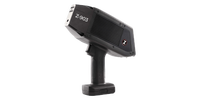
Elemental quantification
Quantification of elemental concentrations using XRF and PFTNA

Quantification of elemental concentrations using XRF and PFTNA

In many applications, knowing the elemental concentration is a critical factor in controlling material properties or to ensure to adhere to health and safety regulations. Therefore, it is often not sufficient to simply detect the presence of elements, but one must also quantify their concentrations.
The degree of accuracy required is application-dependent.
X-ray fluorescence and Pulsed Fast Thermal Neutron Activation are non-destructive, stable and easy-to-use analytical techniques for determining the elemental composition of various materials in a wide range of applications. To quantify elemental concentrations with these techniques, measured intensities are compared to intensities from certified reference materials or in-house standards with known concentrations. These standards should resemble the sample material as closely as possible to obtain accurate results. The measured intensities are also affected by the physical properties of the sample and so various corrections often need to be applied that are taken care of by the user software.

In many industries, a quick screening of sample material of unknown composition is required without having dedicated standards.
In such cases, standardless analysis software such as Omnian can be used to determine the overall elemental composition and provide semi-quantitative values of the elemental concentrations.
Find out more about our elemental quantification instruments below.

ZetiumSmart Zetium for reliable results and robust operation |

Epsilon rangeFast and accurate at- and on-line elemental analysis |

Axios FASTXRF of choice for highest throughput or shortest measurement time |

2830 ZTAdvanced semiconductor thin film metrology solution |

CNA rangeOn-line elemental analyzers for effective control of many industrial processes |

SciAps Z-SeriesSophisticated analysis of ultra-low elemental concentrations |
|
|---|---|---|---|---|---|---|
| Measurement type | ||||||
| Thin film metrology | ||||||
| Contaminant detection and analysis | ||||||
| Chemical identification | ||||||
| Technology | ||||||
| X-ray Fluorescence (XRF) | ||||||
| Wavelength Dispersive X-ray Fluorescence (WDXRF) | ||||||
| Energy Dispersive X-ray Fluorescence (EDXRF) | ||||||
| Pulsed Fast Thermal Neutron Activation (PFTNA) | ||||||
| Elemental range | Be-Am | F-Am | B-Am | B-Am | ||
| LLD | 0.1 ppm - 100% | 1 ppm - 100% | 0.1 ppm - 100% | 0.1 ppm - 100% | ||
| Resolution (Mn-Ka) | 35eV | 145eV | 35eV | 35eV | ||
| Sample throughput | Up to - 240per 8h day | Up to - 160per 8h day | Up to 480 | up to 25 wafers per hour | ||